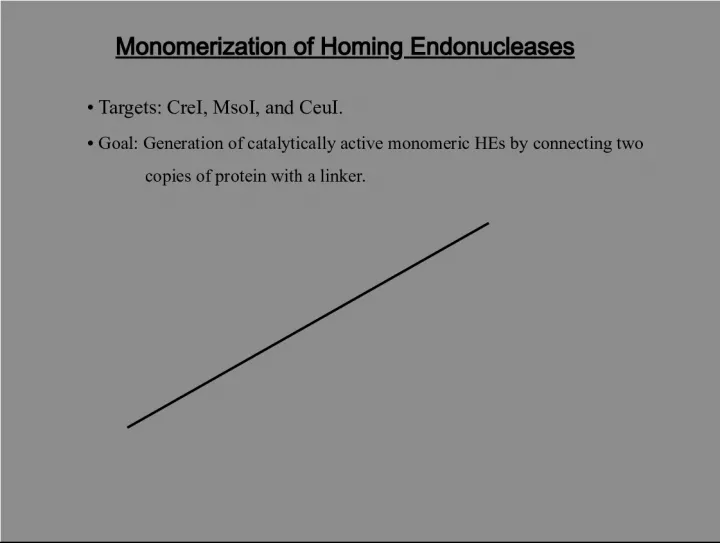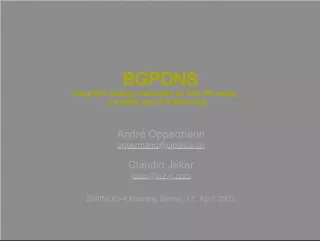Monomerization of Homing Endonucleases Targets CreI, MsoI, and CeuI


The goal of this experiment is to create catalytically active monomeric homing endonucleases (HE
- Uploaded on | 0 Views
-
 sara
sara
About Monomerization of Homing Endonucleases Targets CreI, MsoI, and CeuI
PowerPoint presentation about 'Monomerization of Homing Endonucleases Targets CreI, MsoI, and CeuI'. This presentation describes the topic on The goal of this experiment is to create catalytically active monomeric homing endonucleases (HE. The key topics included in this slideshow are . Download this presentation absolutely free.
Presentation Transcript
Slide1Monomerization of Homing Endonucleases• Targets: CreI, MsoI, and CeuI. • Goal: Generation of catalytically active monomeric HEs by connecting two copies of protein with a linker.
Slide2Procedures• Gene Synthesis Two copies of ORFs ( ~ 65% identity) optimized based on E.coli codon usage with an internal MCS was synthesized ACCGGT ACTAGTG GGTACC AgeI SpeI KpnI • Insertion of a linker library with 60 to 80 amino acid residues between two copies of ORFs. • High-throughput screening or/and in vivo selection to identify active HEs in monomeric form. • Characterization of individual selectants.
Slide3The Linker LibraryScalley-Kim M. et. al. Protein Science (2003), 12: 197-206 SH2 domain V 170 G 175 Random sequences encoding 60-120 amino acids • After three-round selection against SH2 ligand using phage display, a group of peptides with 60-80 amino acid residues were identified to have minimal effects on SH2 domain stability.
Slide4In vivo Selection Doyon JB et. al. J.A.C.S. (2006), 128: 2477-84.
Slide5In Vivo Selection HEs Positive Selection (Active HEs) Background (Inactive HEs) SceI a 20-40% 2.0 ×10 -5 CreI 30-40% 1.5 ×10 -4 MsoI ~30% 1.0×10 -4 • Control experiments a Doyon JB et. al. J.A.C.S. (2006), 128: 2477-84 Note: Two copies of target site were introduced into pCcdB vector.
Slide6Linkers Length of Monomeric HEs• 19 various linkers were identified from Cre library with length from 13 Aa to 73 Aa. • 13 various linkers were identified from Mso library with length at 13 and 33 Aa.
Slide7the composition of randomized portion of the linkers• Ala, Lys, Asn, Pro, and Thr dominant.
Slide8the composition of randomized portion of the linkers• Arg is selected for, and Gly is against.
Slide9the composition of randomized portion of the linkers• Thr is selected for, and Gly, Ser are against.
Slide10In vitro Cleavage • 14 monomeric Cres, and 8 monomeric Msos were cloned into expression vectors, respectively. • All but one (Msomono#96) show in vitro cleavage activity
Slide11Verification of Protein Molecular OrganizationInactive Active
Slide12In vitro Cleavage of Single Active Site Knock-out Monomeric HEs • Single active site knock-out mutation eliminate the cleavage activity in Cremono#15, Msomono#24 and #27 completely, while partially in Cremono#6. • All single active site knock-out mutants show nicking activity against supercoiled substrate.
Slide13In vitro Cleavage of Single Active Site Knock-out Monomeric HEs • Monomeric HEs with 13 Aa linker show non-specific cleavage. • Monomeric Cre with 53 Aa linker shows cleavage activity, while the one with 73 Aa linker doesn’t.
Slide14Conclusion• Majority of monomeric HEs show in vitro cleavage activity, validating the in vivo selection system. • Monomeric Hes with different linkers behave differently in term of the oligomeric organization. Future Works: • Complete the cleavage profile of single active site knock-out mutants. • In vivo activity in human cells using DR-GFP reporter system. • Structural study.
Slide15In vitro Cleavage• WT CreI and MsoI were expressed from pET16b vector in BL21(DE3). • Monomeric CreI and MsoI were expressed from pBAD vector in TOP10. • Proteins were purified Ni-NTA kit (Qiagen).
Slide16Monomeric CreI linkersLinker Sequence Frequency #2 TGSGSGS TNMKPPVRAFEPTGVRSR GSGSGSGT (33Aa) 6/84 #3 TGSGSGS KSQAVAHPTDGQRDFGAK GSGSGSGT (33Aa) 5/84 #6 TGSGSGS KPAGGDAPRLMQGVNRID GSGSGSGT (33Aa) 19/84 #7 TGSGSGSGSGSGT (13Aa) 29/84 #14 TGSGSGS NPRNSPNSKTSMPIDVNN GS AYSMQSNRGYVKEEYLHR GSGS GSGT (53Aa) 1/84 #15 TGSGSGS KTKNMSPKANIERTPENK GSGSGSGT (33Aa) 7/84 #19 TGSGSGS STKERTNLKDNMTIDKPR GSGSGSGT (33Aa) 1/84 #45 TGSGSGS KDVTQANRTYIPRENASR GSGSGSGT (33Aa) 1/84 #48 TGSGSGS TDQAGHDPGAKTAKPMLG GSGSGSGT (33Aa) 1/84 #53 TGSGSGS NYAAKPIPSAGQLETSHN GSGSGSGT (33Aa) 3/84 #56 TGSGSGS IPQTQFHLVLGAAATRDN GS GISETNPRDPTQVSDKNI GS TVT GQVVRTDSLEENKAN GSGSGSGT (73Aa) 2/84 #65 TGSGSGS KTKNMSPSANIERTPDNK GSGSGSGT (33Aa) 1/84 Continued
Slide17LinkerSequence Frequency #81 TGSGSGS KYEGKAILSAGQLDTSYK GSGSGSGT (33Aa) 1/84 #90 TGSGSGS NNKSSHPQGDVEQKHQHS GSGSGSGT (33Aa) 1/84 #102 TGSGSGS TSARLYPQTTATMNDSTM GSGSGSGT (33Aa) 1/84 #119 TGSGSGS NPAMLADPKNTGLATGAI GSGSGSGT (33Aa) 1/84 #121 TGSGSGS NDTEMSSWTAERRTPRPT GSGSGSGT (33Aa) 1/84 #124 TGSGSGS NPGVRSPRNNDLPDHRLI GSGSGSGT (33Aa) 1/84 #125 TGSGSGS NAGNLPSRENNTSKHSAE GSGSGSGT (33Aa) 2/84 Monomeric CreI linkers
Slide18Monomeric MsoI linkersLinker Sequence Frequency #3 TGSGSGS TAAKPPVRTTDGMESTFM GSGSGSGT (33Aa) 1/57 #5 TGSGSGSGSGSGT (13Aa) 15/57 #14 TGSGSGS AYTTTTDEAPTLVKPRHN GSGSGSGT (33Aa) 1/57 #15 TGSGSGS KPTALNPWNIDRTTIPAK GSGSGSGT (13Aa) 6/57 #24 TGSGSGS KHPTLTLPTTTSQENLPN GSGSGSGT (33Aa) 3/57 #25 TGSGSGS RFAGESHVNNTTKTTKLE GSGSGSGT (33Aa) 9/57 #27 TGSGSGS KTKNPHPENPGQSMTQAK GSGSGSGT (33Aa) 1/57 #28 TGSGSGS RFAGESHVNNTTKTTKLE GSGSGSGT (33Aa) 3/57 #29 TGSGSGS THTTRHNRTPTAPNYRPI GSGSGSGT (33Aa) 1/57 #43 TGSGSGS GFANKYNVDHNPLSNMNS GSGSGSGT (33Aa) 1/57 #55 TGSGSGS KTKNPHPWNPDRSTTPAK GSGSGSGT (33Aa) 1/57 #70 TGSGSGS TTQAPPTMTYTRGVATTD GSGSGSGT (33Aa) 1/57 #96 TGSGSGS NLGAENAQSASQKDDALR GSGSGSGT (33Aa) 1/57






